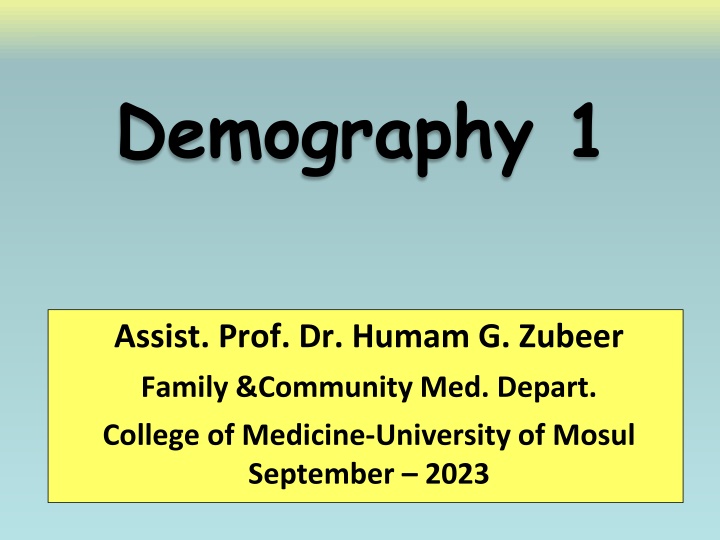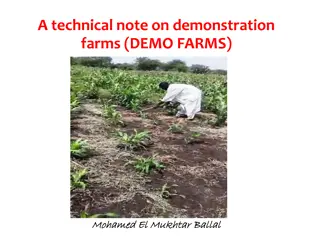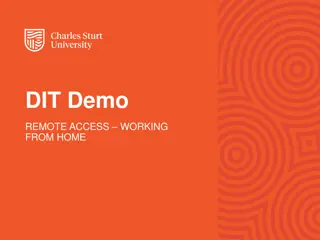
Demography: Study of Population Dynamics and Trends
Demography is the statistical analysis of population characteristics and dynamics over time and place, encompassing size, structure, distribution, and changes in response to various factors. It involves both direct and indirect data collection methods, such as vital statistics registries and censuses, to estimate births, deaths, migration, and other demographic trends. Formal demography focuses on population processes, while social demography considers broader societal influences on populations.
Download Presentation

Please find below an Image/Link to download the presentation.
The content on the website is provided AS IS for your information and personal use only. It may not be sold, licensed, or shared on other websites without obtaining consent from the author. If you encounter any issues during the download, it is possible that the publisher has removed the file from their server.
You are allowed to download the files provided on this website for personal or commercial use, subject to the condition that they are used lawfully. All files are the property of their respective owners.
The content on the website is provided AS IS for your information and personal use only. It may not be sold, licensed, or shared on other websites without obtaining consent from the author.
E N D
Presentation Transcript
Demography 1 Assist. Prof. Dr. Humam G. Zubeer Family &Community Med. Depart. College of Medicine-University of Mosul September 2023
Demography demo- from Ancient Greek d mos meaning "the people", and -graphy from graph , implies "writing, description or measurement") is the statistical study of population. As a very general science, it can analyze any kind of dynamic living population, i.e., one that changes over time or place. Demography encompasses the study of the size, structure, and distribution of these populations, and temporal changes in them in response to birth, migration, aging, and death. Based on the demographic research of the earth, earth's population up to the year 2050 and 2100 can be estimated by demographers. Demographics are quantifiable characteristics of a given population.
Demographic analysis: Can cover whole societies or groups defined by criteria such as education, nationality, religion, and ethnicity. Formal demography limits its object of study to the measurement of population processes, while the broader field of social demography also analyses the relationships between economic, social, cultural, and biological processes influencing a population.
There are two types of data collectiondirect and indirect with several different methods of each type Direct methods Direct data comes from vital statistics registries that track all births and deaths as well as certain changes in legal status such as marriage, divorce, and migration (registration of place of residence). In developed countries with good registration systems (such as the United States and much of Europe), registry statistics are the best method for estimating the number of births and deaths.
A census is the other common direct method of collecting demographic data. A census is usually conducted by a national government and attempts to enumerate every person in a country. In contrast to vital statistics data, which are typically collected continuously and summarized on an annual basis, censuses typically occur only every 10 years or so, and thus are not usually the best source of data on births and deaths. Analyses are conducted after a census to estimate how much over or undercounting took place.
Censuses do more than just count people. They typically collect information about families or households in addition to individual characteristics such as age, sex, marital status, literacy/education, employment status, and occupation, and geographical location. They may also collect data on migration (or place of birth or of previous residence), language, religion, nationality (or ethnicity or race). In countries in which the vital registration system may be incomplete, the censuses are also used as a direct source of information about fertility and mortality.
Indirect methods Indirect methods of collecting data are required in countries and periods where full data are not available, such as is the case in much of the developing world. One of these techniques in contemporary demography is the sister method, where survey researchers ask women how many of their sisters have died or had children and at what age. With these surveys, researchers can then indirectly estimate birth or death rates for the entire population. Other indirect methods include asking people about siblings, parents, and children.
There are a variety of demographic methods for modeling population processes. They include models of mortality, fertility, marriage and disability. The United Kingdom has a series of four national birth cohort studies, the first three spaced apart by 12 years: the 1946 National Survey of Health and Development, the 1958 National Child Development Study, the 1970 British Cohort Study, and the Millennium Cohort Study in 2000. These have followed the lives of samples of people (typically beginning with around 17,000 in each study) for many years, and are still continuing. As the samples have been drawn in a nationally representative way, inferences can be drawn from these studies about the differences between four distinct generations of British people in terms of their health, education, attitudes, childbearing and employment patterns.
Population historical events can populations contamination). conditions influence affect significantly medicine, environmental history and (war, Population communicated in terms of numbers and rates. To be useful, data must be expressed clearly as well as accurately. information is best
Tools in demography Count The absolute number of a population or any demographic event occurring in a specified area in a specified time period. For example 1 200 500 live birth occurred in Iraq in 2017. It is the base of all statistical analyses in demography.
The frequency of demographic events in a population during a specified time period (usually a year) divided by the population at risk of event occurring during that time period Rate Most expressed 1000 population. rates are per Crude rates computed for entire population. rates are Ratio and proportion
Constant An unchanging arbitrary number for example, 100, 1000, 100 000 by which rates, ratios, or proportion can be multiplied to express the measures in a more understandable fashion. K means constant.
Cohort measure A statistics that measures events occurring to a cohort (a group of people sharing a common demographic experience) who are observed through time . e.g. birth cohort i.e. people born in the same year or period . Marriage cohorts, school class cohorts
Census Census is process for enumeration of individuals all over country at a certain time in addition to collection of demographic and socio-demographic data about that population. Special census sheet have to be filled in with these data by family members or by trained personal.
Uses of population census 1. Gives population profile of the population characteristics . 2. Provides the needs data for calculation of statistical indicators required for: ? Measuring health, national demographic, socio-economic aspect ? Planning and evaluation of different national and community programs
Uses of population census 3. Helps determining the denominators of various indicators. 4. For political and administrative purpose.
Census method (residence definition) 1. Defacto population (in fact) : i.e. the actual population present in the census area on census day. It is also known as the present-in- area or the enumerated population.
Census methods It has the following characteristics It avoids the distinction between temporary and permanent residence. People in transit present problems for enumeration and may be missed. Gives false impression of size in areas with light migration or high seasonal mobility .
2. Dejure population: All permanent residence who habitually live in the census area will be included. It is also known as the resident population.
Dejure population Its main characteristics It requires a clear definition of permanent residence which may be difficult in a population with high mobility to differentiate it from temporary residence . Residents temporarily away present a problem and may be missed.
Technically free form influence of short- term or seasonal mobility or migration but it may not reflect the size of population actually present in the area at given time.
It is necessary to have a precise definition of residence to decide whether visitors to a country should be included in the population count. Other groups causing problems of enumeration are new born babies, refugees, people away on holiday, people moving home around census day, and people without a fixed address.
People having second homes because of working in another part of the country or retaining a holiday cottage are difficult to fix at a particular address sometimes causing double counting.
Census Census in Iraq 1927 1947 1957 1987 1997 1965 1977















